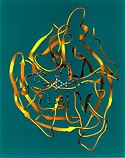Neuraminidaza
Neuraminidaza (EC 3.2.1.18[1]) – należący do glikoprotein enzym odpowiedzialny za rozkład kwasu sjalowego, występujący w wirusach grypy[2].
Enzym ten umożliwia wirusom opuszczanie komórek przez rozpad błony komórkowej zarażonej komórki. Pozwala on także na przyłączenie się wirusa do błony komórkowej, co ułatwia wnikanie do wnętrza komórki (neuraminidaza ma duże powinowactwo do kwasu sjalowego receptorów błonowych).
Zobacz też
Przypisy
- ↑ ENZYME entry 3.2.1.18, www.expasy.org [dostęp 2017-11-25] (ang.).
- ↑ Hans Günter Schlegel: Mikrobiologia ogólna. Warszawa: Wydawnictwo Naukowe PWN, 2003, s. 177. ISBN 83-01-13999-4.
Media użyte na tej stronie
Neuraminidase Ribbon Diagram Ribbons is a program developed at UAB used worldwide to graphically depict complicated protein structures in a simplified format. The program uses sophisticated computer systems to understand the implications of protein structures. The Influenza virus remains a major causative agent for a large number of deaths among the elderly and young children and huge economic losses due to illness. Finding a cure will have a general impact both on the basic research of viral pathologists of fast evolving infectious agents and clinical treatment of influenza virus infection. The reproduction process of all strains of influenza are dependent on the same enzyme neuraminidase. Shown here is a segmented representation of the neuraminidase inhibitor compound sitting inside a cave-like contour of the neuraminidase enzyme surface. This cave-like formation present in every neuraminidase enzyme is the active site crucial to the flu's ability to infect. The space-grown crystals of neuraminidase have provided significant new details about the three-dimensional characteristics of this active site thus allowing researchers to design drugs that fit tighter into the site. Principal Investigator: Dr. Larry DeLucas

